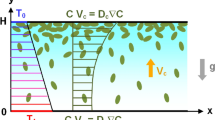Abstract
A set of nonlinear differential equations describing the parameters during the rise of a thermal (its velocity, radius, and excess temperature) as a function of height and time is numerically solved. It is found that the rise velocity varies nonmonotonically: it increases rapidly at first and its increase rate decreases with the increasing drag of the incoming air; for a long time (tens to thousands of seconds), this velocity remains close to the maximum (approximately 10…180 m/s), and then it decreases relatively slowly (for hundreds to thousands of seconds) to zero. It is shown that the more the thermal is heated and the larger its size, the faster it rises and reaches higher altitudes for a longer time. During the rise, the radius of the thermal increases by a factor of 6…25 depending on its initial size and initial temperature due to the entrained cold air. The greater the current radius value, the higher the increase rate of the thermal radius. The size of a small thermal increases by more times than that of a big thermal. The thermal radius increases until it is completely stopped. Less heated thermals rise more slowly, entrain smaller amounts of cold air, and increase less in size. It is shown that the cooling rate is proportional to the thermal rise velocity and is maximum when the maximum value of this velocity is reached. The warmer thermal cools more rapidly than the less heated one. The thermal cooling rate depends relatively weakly on its initial size. The limitations of the used model (the uniformity and isothermality of the atmosphere and neglect of the effect of thermal radiation, wind, and turbulence on the thermal cooling) are discussed. Despite the limitations, in general, the model is confirmed by the results of observations of the rise of the thermal generated during the explosion of the Chelyabinsk meteoroid.
Similar content being viewed by others
REFERENCES
Asteroid-Comet Hazard: Yesterday, Today, Tomorrow, Ed. by B. M. Shustov and L. V. Rykhlova (Fizmatlit, Moscow, 2010) [in Russian].
N. N. Gor’kavyi and T. A. Taidakova, “Interaction of the Chelyabinsk bolide with the atmosphere,” in Proc. A-ll-Russ. Sci. Conf. Chelyabinsk Meteorite: A Year on Earth, Chelyabinsk, Feb. 14–15, 2014, Ed. by N. A. Antipin, et al. (Chelyabinskii Gos. Kraevedcheskii Muzei, 2014), pp. 124–129.
N. N. Gor’kavyi, T. A. Taidakova, E. A. Provornikova, I. N. Gor’kavyi, and M. M. Akhmetvaleev, “The aerosol trail of the Chelyabinsk bolide,” in Proc. All-Russ. Sci. Conf. Chelyabinsk Meteorite: A Year on Earth, Chelyabinsk, Chelyabinsk, Feb. 14–15, 2014, 2014, Ed. by N. A. Antipin, et al. (Chelyabinskii Gos. Kraevedcheskii Muzei, 2014), pp. 130–135.
E. E. Gossard and W. H. Hooke, Waves in the Atmosphere: Atmospheric Infrasound and Gravity Waves: Their Generation and Propagation (Elsevier, Amsterdam, 1975; Mir, Moscow, 1978).
Yu. A. Gostintsev and Yu. V. Shatskikh, “Mechanism of longwave acoustic perturbation generation in the atmosphere by a floating cloud of explosion products,” Combustion Explosion and Shock Waves, No. 2, 203–208 (1987).
Catastrophic Events Caused by Cosmic Objects, Ed. by V. V. Adushkin and I. V. Nemchinov (Akademkniga, Moscow, 2005; Springer-Verlag, Dordrecht, 2007).
L. F. Chernogor, “Plasma, electromagnetic and acoustic effects of the Chelyabinsk meteorite,” Inzh. Fiz., No. 8, 23–40 (2013).
L. F. Chernogor, “Physical effects of the passage of the Chelyabinsk meteorite,” Dop. Nats. Akad. Nauk Ukrainy, No. 10, 97–104 (2013).
L. F. Chernogor, “Atmospheric effects of the gas-and-dust trail of the 2013 Chelyabinsk meteoroid,” Izvestiya. Atmospheric and Oceanic Physics. 53, 259–268 (2017).
L. F. Chernogor, “Magnetic and ionospheric effects of a meteoroid plume,” Geomagn. Aeron. (Engl. Transl.) 58, 125–132 (2018).
V. R. Morton, G. Taylor, and J. S. Turner, “Turbulent gravitational convection from maintained and instantaneous sources,” in Proc. R. Soc. London A 234, 1–23 (1956).
O. P. Popova, P. Jenniskens, V. Emelyanenko, et al., “Chelyabinsk airburst, damage assessment, meteorite, and characterization,” Science 342, 1069–1073 (2013).
Author information
Authors and Affiliations
Corresponding author
Additional information
Translated by O. Pismenov
About this article
Cite this article
Chernogor, L.F., Mylovanov, Y.B. Rise of a Meteoroid Thermal in the Earth’s Atmosphere. Kinemat. Phys. Celest. Bodies 34, 198–206 (2018). https://doi.org/10.3103/S0884591318040025
Received:
Published:
Issue Date:
DOI: https://doi.org/10.3103/S0884591318040025




